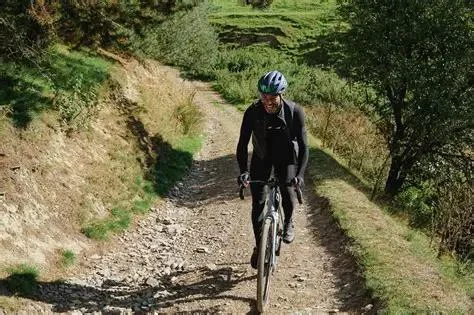
- gravel-biking-culture-in-the-us
- freedom-and-flexibility-of-riding
- the-appeal-of-lesser-known-trails
- technological-advancements-in-gravel-bikes
- community-and-events-are-driving-growth
- real-riders-real-stories
- where-to-start-your-gravel-journey
1. Gravel Biking Culture in the US
Once considered a niche activity, gravel biking has rapidly surged into the mainstream in the US. Riders across the country are trading in crowded paved routes for remote gravel paths, eager to explore untouched countryside and rediscover the roots of cycling. What began as a fringe movement in the Midwest has grown into a nationwide trend, uniting cyclists from all skill levels.
The reason? Gravel biking offers an unmatched sense of adventure and a break from conventional rides. It’s not just a mode of transport—it's a lifestyle.
2. Freedom and Flexibility of Riding
2.1 Escape the Urban Grind
For many riders, the biggest draw is the chance to disconnect. Gravel routes cut through forests, hills, and deserts where traffic lights and city noise are nonexistent. Riders are free to roam at their own pace, without worrying about aggressive drivers or stop-and-go interruptions.
2.2 Ride on Your Own Terms
Gravel biking doesn’t demand the perfect conditions of road cycling or the technical expertise of mountain biking. Whether you’re tackling 10 miles of smooth dirt roads or climbing rocky hills in Colorado, gravel riding is adaptable. It embraces both casual weekend warriors and competitive endurance athletes alike.
3. The Appeal of Lesser-Known Trails
Unlike traditional road races, gravel biking celebrates the unbeaten path. Riders are encouraged to explore unfamiliar territory—rural gravel roads, fire access trails, even forgotten logging routes. Many of these paths aren’t marked on maps, making each ride a small-scale expedition.
States like Kansas, Idaho, and Vermont have become unexpected gravel hotspots, offering thousands of miles of scenic, low-traffic roads ideal for adventure seekers.
4. Technological Advancements in Gravel Bikes
Gravel-specific bikes are a huge factor in this boom. Brands now offer models designed with wider tires, vibration-dampening frames, and dropper posts—all optimized for varied terrain. Tubeless tires, for instance, allow for lower pressures, increasing grip and reducing flats on sharp gravel.
Modern gravel bikes blend speed and durability, and many cyclists now prefer them as all-purpose bikes—great for commuting, racing, and exploring. If you’re unsure what model to try, Cycling Guider can help you choose gear tailored to your riding style and budget.
5. Community and Events Are Driving Growth
5.1 The Rise of Gravel Races
Events like Unbound Gravel in Kansas and SBT GRVL in Colorado have gained international attention. But these aren’t just races—they’re cultural celebrations of grit, camaraderie, and outdoor endurance. Finish times matter less than the shared journey.
5.2 Inclusive and Welcoming
Unlike many competitive cycling events, gravel biking prides itself on inclusivity. There’s space for all body types, ages, and experience levels. Beginners are welcomed as warmly as elite racers. This open atmosphere has helped gravel cycling build a community where everyone feels they belong.
6. Real Riders, Real Stories
Maria, a 42-year-old teacher from Oregon, began gravel biking during the pandemic to escape screen fatigue. What started as weekend rides soon became cross-state solo trips. “It’s therapy,” she says. “Out there on the gravel, I remember who I am.”
Then there’s Derek, a former triathlete who found new purpose through gravel cycling after a knee injury. “The terrain varies enough to keep it challenging but isn’t brutal like technical MTB courses,” he explains. “Plus, the people are just chill.”
7. Where to Start Your Gravel Journey
If the idea of exploring open trails, connecting with a vibrant cycling community, and challenging your limits appeals to you, now is the perfect time to join the gravel movement. Start by finding the right bike and gear—Cycling Guider offers trusted reviews and tips tailored to gravel beginners.
From weekend escapes to ultra-endurance events, gravel biking lets you write your own cycling story. And as more riders hit the backroads, it’s clear this isn’t a passing trend—it’s a revolution.







 Billet BMX5.0 (2 reviews)
Billet BMX5.0 (2 reviews) Far East Children Bicycle Factory1.0 (1 reviews)
Far East Children Bicycle Factory1.0 (1 reviews) Archer Motorsports, Inc.4.0 (8 reviews)
Archer Motorsports, Inc.4.0 (8 reviews) YEP Bike Works4.0 (55 reviews)
YEP Bike Works4.0 (55 reviews) Gorham Bike & Ski4.0 (498 reviews)
Gorham Bike & Ski4.0 (498 reviews) Alchemy Bikes4.0 (37 reviews)
Alchemy Bikes4.0 (37 reviews) How to Teach Kids to Ride a Bike: A Step-by-Step Guide for Parents
How to Teach Kids to Ride a Bike: A Step-by-Step Guide for Parents Tips for Riding on Busy City Streets: Smart Strategies for Urban Cyclists
Tips for Riding on Busy City Streets: Smart Strategies for Urban Cyclists Best US National Parks for Mountain Biking: Ride Epic Trails Across America
Best US National Parks for Mountain Biking: Ride Epic Trails Across America Best Aero Helmets for Time Trials and Racing
Best Aero Helmets for Time Trials and Racing How to Clean and Lubricate Your Bike Chain Like a Pro
How to Clean and Lubricate Your Bike Chain Like a Pro 10 Must-Have Items for Long-Distance Cycling Trips
10 Must-Have Items for Long-Distance Cycling Trips